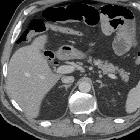gallstone ileus



















































Gallstone ileus is an uncommon cause of a mechanical small bowel obstruction. It is a rare complication of chronic cholecystitis and occurs when a gallstone passes through a fistula between the gallbladder and small bowel before becoming impacted at the ileocecal valve.
Epidemiology
Although overall gallstone ileus is an uncommon cause of small bowel obstruction (1-4% in general adult population ), in the elderly is not uncommon, and accounts for up to 25% of non-strangulated bowel obstructions . As is the case with cholelithiasis, women are more frequently affected .
Clinical presentation
Typically patients have a long history of recurrent right upper quadrant pain, in keeping with chronic cholecystitis with repeated inflammatory events . Gallstone ileus can acutely present as colicky abdominal pain and abdominal distension in the course of small bowel obstruction.
Pathology
Repeated bouts of cholecystitis result in adhesion of the gallbladder to the small bowel (usually duodenum) with eventual fistula formation and passage of gallstones into the lumen. The most common site of entry by erosion is thought to be to the duodenum . Small stones presumably pass without incidence. However, large cholesterol stones can become impacted typically at the ileocecal valve . As such, gallstone ileus is a mechanical small bowel obstruction. Ileus is a misnomer as the term ileus is usually used to describe a functional, rather than, mechanical obstruction.
Radiographic features
Most frequently, stones become impacted in the distal ileum, although they may become lodged at other locations :
- terminal ileum: most common
- proximal ileum
- jejunum
- colon
- duodenum/stomach: leading to gastric outlet obstruction (Bouveret syndrome)
Plain radiograph
Classically the findings on abdominal radiographs are that of small bowel obstruction, gas within the biliary tree, and a gallstone (usually in the right iliac fossa): Rigler triad.
CT
The overall sensitivity, specificity, and accuracy of CT in diagnosing gallstone ileus is around 93%, 100%; and 99%, respectively .
Appearances are those of Rigler triad, better seen than on plain radiograph. Since only the minority of gallstones calcify (12.5%), and their density is similar to regular bowel content, it is easy to overlook the offending gallstone . There may be bulging of the bowel just before the transition point which may be helpful in locating the gallstone. Typically, stones are large and measure several centimeters (2-3 cm).
Additionally, the site of fistulization is seen. Most commonly occurring between the gallbladder and the duodenum. Demonstrated on barium meal as contrast collection lateral to the first part of duodenum.
It is important to look for free fluid, free gas, portal venous gas, or mural gas, as signs of more advanced disease and poorer prognosis.
Treatment and prognosis
Due to the demographics of the population affected (elderly), this condition continues to have high mortality (12-30%) .
Surgery is definitive, with the removal of the stone (enterolithotomy) and repair of the choledochoenteric fistula, accompanied by a cholecystectomy.
History and etymology
The first descriptions of gallstone ileus occurred in 1654 by Thomas Bartholin (1616-1680), a Danish physician, naturalist, physiologist, and anatomist .
Differential diagnosis
The differential is that of each component of Rigler triad:
Siehe auch:
- Aerobilie
- Dünndarmileus
- Bouveret-Syndrom
- Ileus
- Rigler-Trias bei Gallensteinileus
- abdominelle und pelvine Verkalkungen
- duodenobiliäre Fistel
- Cholezystoduodenale Fistel
- enterobiläre Fistel
- spontaneous aerobilia
- okkulte Gallenblasenperforation
- Ileus durch Kotstein
und weiter:

 Assoziationen und Differentialdiagnosen zu Gallensteinileus:
Assoziationen und Differentialdiagnosen zu Gallensteinileus:






